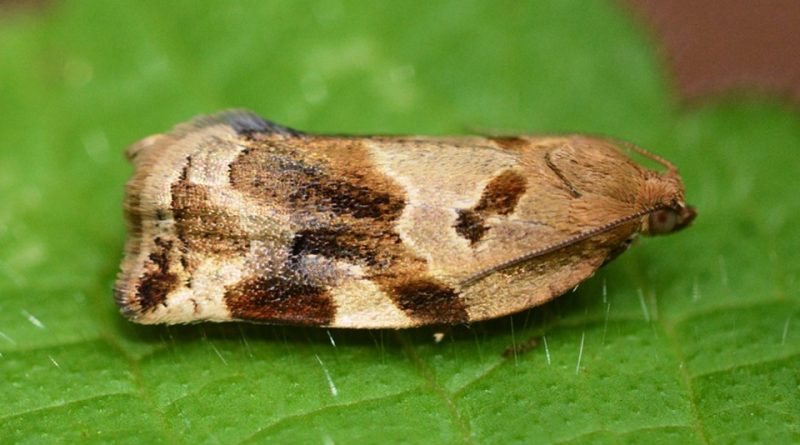Choristoneura lafauryana
Choristoneura lafauryana
The Strawberry leafroller or Sweet-gale Twist (Choristoneura lafauryana Ragonot, 1875) is an insect belonging to the Tortricidae family.
Systematics –
From a systematic point of view it belongs to:
Eukaryota domain,
Kingdom Animalia,
Subkingdom Eumetazoa,
Superphylum Protostomia,
Phylum Arthropoda,
Subphylum Tracheata,
Superclass Hexapoda,
Class Insecta,
Subclass Pterygota,
Endopterygota cohort,
Superorder Oligoneoptera,
Panorpoid section,
Order Lepidoptera,
Glossata suborder,
Infraorder Heteroneura,
Ditrysia division,
Superfamily Tortricoidea,
Family Tortricidae,
Subfamily Tortricinae,
Tortricini tribe,
Genus Choristoneura,
Species C. lafauryana.
The term is basionym:
– Tortrix lafauryana Ragonot, 1875.
The terms are synonyms:
– Archips inornatanus Walsingham, 1900;
– Cacoecia laufauriana Kennel, in Spuler, 1910.
Geographic Distribution and Habitat –
Choristoneura lafauryana is a moth that lives and reproduces in various countries; we find it in Spain, Great Britain, the Netherlands, Belgium, France, Germany, Switzerland, Italy, Romania and Russia. In the east, populations extend as far as China (Heilongjiang, Jilin, Liaoning), Korea and Japan.
The larvae of this moth feed on Artemisia (including Artemisia montana), Cirsium, Lespedeza, Ribes, Myrica (including Myrica gale), Forsythia, Larix, Fragaria (including Fragaria x ananassa), Pyrus and Salix species, as well as Rhododendron tomentosa, Glycine max, Medicago sativa, Trifolium repens, Morella rubra, Boehmeria nivea, Malus pumila and Malus sylvestris.
Morphology –
Choristoneura lafauryana is a moth that has a wingspan of 18-21 mm in males and 20-24 mm in females.
The forewings are yellow-ochre or yellow-brown with reddish-brown spots and streaks. The wings have a strong silky sheen. In females the markings are reduced. The rear wings are light gray or cream-ochre.
The larva has an average length of 25 mm; its head is pale yellowish brown mixed with brownish or yellowish green.
The body is yellowish green with a darker green topline; prothoracic shield and anal shield are pale yellowish brown or dark green.
The pupa is shiny black.
Attitude and biological cycle –
Choristoneura lafauryana is an insect that winters in the larval stage, in silky protections, placed between the bark of occasional shelter plants or between the dry leaves at the base of trees or at the edges of cultivated fields.
Arrived in spring, the larvae resume their trophic activity on the young vegetation; the adults of the 1st flight then flicker at the end of May-June.
The eggs are deposited in elongated batches of 70-100 eggs on the upper surface of the leaves of the food plant.
These adults originate the first larval generation which carries out its activity in midsummer.
From these larvae originate the adults of the 2nd flight which flicker at the end of summer, in the period of the third ten days of August. These adults originate the second generation larvae, destined to overwinter.
In this way the moth therefore completes two generations a year.
Ecological Role –
Choristoneura lafauryana is a moth distributed mainly in central-western Europe with some findings in Romania and in southern European Russia, up to China, Korea and Japan. In Italy it is not detected in the islands.
This insect is polyphagous and feeds on multiple herbaceous and fruit-bearing plants, in particular it can be found on Fragaria sp (strawberry), Glycine max (soybean).
The damage is caused by the larvae which cause erosion, more or less intense, on the vegetation, curling up and covering the leaves and part of the top with silky threads.
Together with other tortricids, it can also directly affect the floral organs and fruits, causing even greater damage, with the subsequent and intense development of Botrytis, due to the lesions caused.
The fight against this moth has so far been chemical following the criteria of guided and integrated fight.
Intervention begins with sampling or monitoring the population before implementing any type of intervention.
Monitoring can be done with sex traps, generally installed in mid-May. Sex traps are useful both for assessing the actual presence of the pest and for following the evolution of populations.
It should be underlined how chemical interventions should be carried out only in case of real need and only in case of strong and serious infestations, which are still quite rare.
In recent times we have intervened, with biological control programs, through the use of Bacillus thuringiensis ssp. kurstaki.
Guido Bissanti
Sources
– Wikipedia, the free encyclopedia.
– GBIF, the Global Biodiversity Information Facility.
– Russo G., 1976. Agricultural entomology. Special Part. Liguori Publisher, Naples.
– Pollini A., 2002. Handbook of applied entomology. Edagricole, Bologna.
– Tremblay E., 1997. Applied entomology. Liguori Publisher, Naples.

